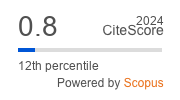Contact and contactless methods for measuring the parameters of porous silicon
https://doi.org/10.17073/1609-3577-2018-2-112-121
Abstract
About the Authors
N. V. LatukhinaRussian Federation
34 Moskovskoye shosse, Samara 443086
Natalya V. Latukhina: Cand. Sci. (Eng.), Associate Professor
S. P. Kobeleva
Russian Federation
4 Leninsky Prospekt, Moscow 119049
Svetlana P. Kobeleva: Cand. Sci. (Phys.-Math.), Associate Professor
G. A. Rogozhina
Russian Federation
34 Moskovskoye shosse, Samara 443086
Galina A. Rogozhina: Assistant
I. A. Shishkin
Russian Federation
34 Moskovskoye shosse, Samara 443086
Ivan A. Shishkin: Student
I. V. Schemerov
Russian Federation
4 Leninsky Prospekt, Moscow 119049
Ivan V. Schemerov: Cand. Sci. (Eng.), Engineer
References
1. Zimin S. P. Classification of electrical properties of porous silicon. Semiconductors, 2000, vol. 34, no. 3, pp. 353—357. DOI: 10.1134/1.1187985
2. Bisi S., Ossicini S., Pavesi L. Porous silicon: a quantum sponge structure for silicon based optoelectronics. Surf. Sci. Rep., 2000, vol. 38, no. 1–3, pp. l—126. DOI: 10.1016/S0167-5729(99)00012-6
3. Zimin S. P. Hopping conductivity in low-porosity mesoporous silicon formed on p+-Si:B. Semiconductors, 2006, vol. 40, no. 11, pp. 1350—1352. DOI: 10.1134/S1063782606110170
4. Sakun E. A., Polyushkevich A. V., Harlashin P. A., Semenova O. V., Korets A. Ya. Development of porous structures on silicon. J. Siberian Federal University. Engineering & Technologies, 2010, vol. 4, no. 3, pp. 430—443. (In Russ.)
5. Tynyshtykbaev K. B., Ryabikin Yu. A., Tokmoldin S. Zh., Aitmukan T., Rakymetov B. A., Vermenichev R. B. Morfologiya of porous silicon at long anode etching in electrolyte with an internal source of current. Pis’ma v zhurnal tekhnicheskoi fiziki, 2010, vol. 36, no. 11, pp. 104—110. (In Russ.)
6. Goryachev D. N., Belyakov L. V., Sreseli O. M. On the mechanism of porous silicon formation. Semiconductors, 2000, vol. 34, no. 9, pp. 1090—1093. DOI: 10.1134/1.1309429
7. Buchin E. Yu., Prokaznikov A. V. Character of n-type electrolyte system dynamics when anodized in hydrofluoric acid solutions. Pis’ma v zhurnal tekhnicheskoi fiziki, 1997, vol. 23, no. 5, pp. 1—7. (In Russ.)
8. Mozhaev A. V., Prokaznikov A. V., Timofeev V. V. Dynamic discrete three-dimensional model of pore formation in silicon. Issledovano v Rossii = Investigated in Russia. (In Russ.). URL: http://zhurnal.ape.relarn.ru/articles/2006/069
9. Xiaoge Gregory Zhang. Electrochemistry of Silicon and Its Oxide. N. Y.; Boston; Dordrecht; London; Moscow: Kluwer Academic Publishers, 2004, 510 p.
10. Allongue P., Kieling V., Gerischer H. Etching mechanism and atomic structure of H-Si(111) surfaces prepared in NH4F. Electrochimica Acta, 1995, vol. 40, no. 10, pp. 1353—1360. DOI: 10.1016/0013-4686(95)00071-L
11. Tregulov V. V. Poristyi kremnii: tekhnologiya, svoistva, primenenie [Porous Silicon: Technology, Properties, Application]. Ryazan: RGU im. S. A. Esenina, 2011, p. 24. (In Russ.)
12. Ulin V. P., Ulin N. V., Soldatenkov F. Y.Anodic processes in the chemical and electrochemical etching of Si crystals in acid-fluoride solutions: Pore formation mechanism. Semiconductors, 2017, vol. 51, no. 4, pp. 458—472. DOI: 10.1134/S1063782617040212
13. Ulin V. P., Konnikov S. G. The nature of electrochemical pore-formation in AIIIBV crystals (Pt I). Fizika i tekhnika poluprovodnikov = Semiconductors, 2007, vol. 41, no. 7, pp. 854—866. (In Russ.)
14. Kunakbaev T. Zh., Tukubaev E. E. Modelirovanie polucheniya poristogo kremniya na atomnom urovne [Simulation of porous silicon production at the atomic level].Khaos i struktury v nelineinykh sistemakh. Teoriya i eksperement. Mezhdun. nauchno-prakt. konferentsiya = Chaos and structures in nonlinear systems. Theory and experiment. International scientific and practical the conference. 2015, no. 1, pp. 171—176. (In Russ.). URL: http://portal.kazntu.kz/files/publicate/2015-10-26-elbib_11.pdf
15. Piskazhova T. V., Savenkova N. P., Anpilov S. V., Kalmykov A. V., Zaitsev F. S., Anikeev F. A. Three-dimensional mathematical modeling of dynamics interfaces between aluminum, electrolytes and reverse zone of oxidized metal depending on the potencial distribution. J. Siberian Federal University. Engineering & Technologies, 2017, vol. 10, no. 1, pp. 59—73. (In Russ.). DOI: 10.17516/1999-494X-2017-10-1-59-73
16. Gorodetsky A. E., Tarasova I. L. Simulation of porous silicon structure formation. Math. Models Comput. Simul. 2009, vol. 1, no. 1, pp. 124—130. DOI: 10.1134/S207004820901013X
17. Latukhina N. V., Dereglazova T. S., Ivkov S. V., Volkov A. V., Deeva V. A. Photoelectrical properties of structure with micro- and nano-porous silicon. Izvestia of Samara Scientific Center of the Russian Academy of Sciences, 2009, vol. 11, no. 3, pp. 66—70. URL: http://www.ssc.smr.ru/media/journals/izvestia/2009/2009_3_66_70.pdf
18. Anfimov I. M., Kobeleva S. P., Shchemerov I. V. Ustanovka dlya izmereniya udel’nogo elektrosoprotivleniya beskontaktnym SVCh metodom [Installation for measuring the electrical resistivity by a contactless microwave method]. Materialy I mezhdunarodnoi konf. «Aktual’nye problemy prikladnoi fiziki 2012» = Materials of the I International Conf. «Actual problems of applied physics 2012». Sevastopol, 2012, pp. 82—83.
19. Lizunkova D., Latukhina N., Chepurnov V., Paranin V. Nanocrystalline silicon and silicon carbide optical properties. Proc. International conference Information Technology and Nanotechnology. Session Computer Optics and Nanophotonics. Samara (Russia), 2017, vol. 1900, pp. 84—89. DOI: 10.18287/1613-0073-2017-1900-84-89
Review
For citations:
Latukhina N.V., Kobeleva S.P., Rogozhina G.A., Shishkin I.A., Schemerov I.V. Contact and contactless methods for measuring the parameters of porous silicon. Izvestiya Vysshikh Uchebnykh Zavedenii. Materialy Elektronnoi Tekhniki = Materials of Electronics Engineering. 2018;21(2):112-121. (In Russ.) https://doi.org/10.17073/1609-3577-2018-2-112-121





































